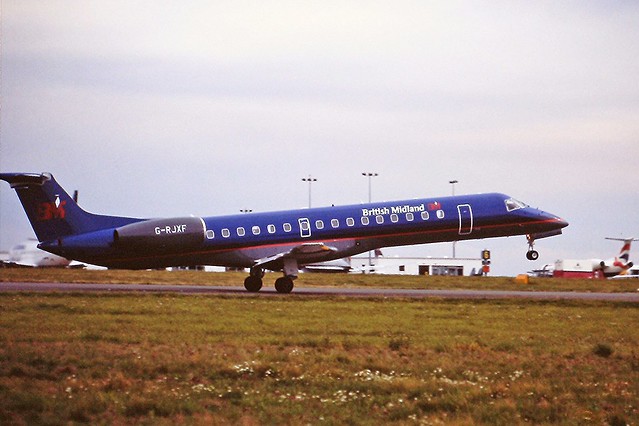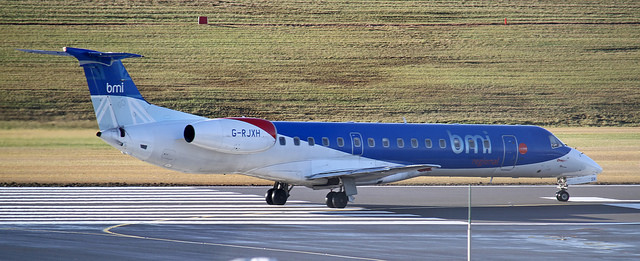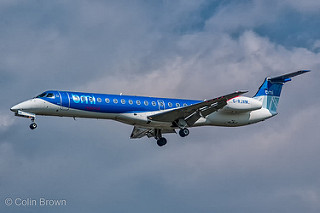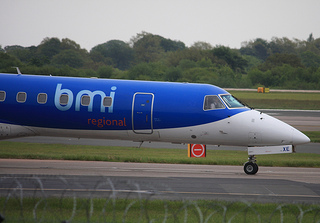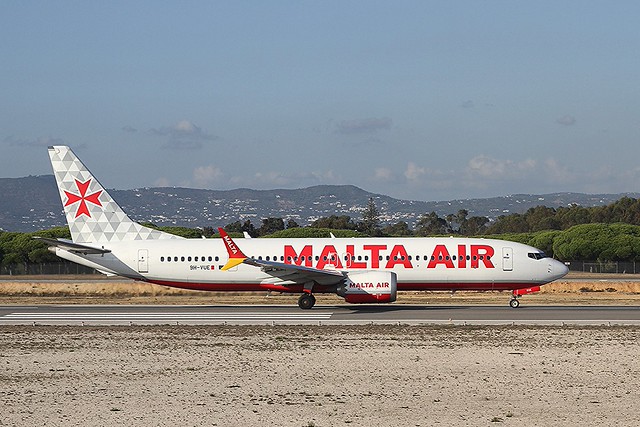bmi E145 at Bristol on Dec 22nd 2017, runway excursion on landing
Last Update: January 10, 2019 / 15:28:30 GMT/Zulu time
Incident Facts
Date of incident
Dec 22, 2017
Classification
Incident
Cause
Runway excursion
Airline
BMI Regional
Flight number
BM-1822
Departure
Frankfurt/Main, Germany
Destination
Bristol, United Kingdom
Aircraft Registration
G-CKAG
Aircraft Type
Embraer ERJ-145
ICAO Type Designator
E145
Airport ICAO Code
EGGD
The aerodrome was closed for almost the rest of the day as result and re-opened after about 13 hours.
The airport reported after landing the aircraft went off the runway while taxiing. The passengers disembarked and were taken to the terminal. The aircraft is to be towed to the apron.
The airline confirmed the aircraft encountered an incident while landing in Bristol, all 22 passengers and 3 crew are safe.
The British AAIB dispatched investigators on site and opened an investigation.
On Jan 10th 2019 the AAIB released their bulletin concluding the probable causes of the accident were:
The accident arose as a result of the inadvertent selection of the Emergency/Parking brake instead of the speed brake. The levers are of similar shape and sited close to each other but with a different appearance and mode of action. There is also a brake on indicator light. These risk controls proved ineffective in preventing the inadvertent selection of the Emergency/parking brake both on this occasion and on at least two previous occasions. Once the parking brake had been set there were opportunities to detect and correct the error, but a busy flight deck environment together with a high workload contributed to it going unnoticed.
After touchdown, the aircraft may have remained on the runway surface but for the addition of forward thrust during the landing roll.
The manufacturer stated that it did not intend to conduct a system review relating to the parking brake status.
The AAIB reported the left hand seat was occupied by a captain under training, new to both the operator and the aircraft type, the trainee was pilot flying (in the following referred to as trainee). The right hand seat was occupied by a training captain, who also was commander of the flight (in the following referred to as commander) and assumed the role as pilot monitoring.
The crew performed an ILS CAT II approach to Bristol's runway 27. While descending through FL140 ATC advised they had 30 track miles to go, wheher this was sufficient to descend, the crew accepted. The trainee decided to use the speed brakes to lose altitude and announced "Speed Brake coming on", however, on the flight data recorder no speed brake deployment was recorded.
About two minutes later, while the crew conducted a radio altimeter test interrupting their communications for about two minutes, the commander commented deploying the speed brakes and using speed mode would be the quickest way to descend. The trainee acknowledged and responded that they [the speedbrakes] were already open, however, the commander just responded to an ATC call and did not notice the trainees reply.
Another minute the captain again commented the speed brakes would be the quickest way to get down, the trainee responded "It is, oh no, it's not, who closed that?" He deployed the speed brake which now also indicated on the flight data recorder. The trainee requested another 5 track miles for descent.
The AAIB wrote:
The aircraft was routed by ATC through the extended runway centreline to provide the requested additional distance before being turned to intercept the ILS localiser from the south. The descent checklist was completed and the approach checklist was started. At the second item, ‘Seatbelt Sign ….ON’, the commander instead read out “park brake” and the PF responded “on” (Figure 1). This was immediately followed by an instruction from ATC to descend to 2,500 ft and turn right heading 360°. The crew followed the ATC instructions and then, because of the interruption, the commander restarted the approach checklist from the beginning, this time completing it as published.
The approach continued, the required visual references for landing were achieved and, at 80 ft agl, the PF disconnected the autopilot in accordance with procedures for a manual landing.
On touchdown, the PF noticed an unusually rapid de-rotation and then found he had difficulty in maintaining directional control despite using corrective rudder. The commander thought that the PF might be “riding the brakes”, a common error during training, and advised him to take his feet off the brakes. The PF, still unable to control the aircraft, attempted to use the steering tiller but when the commander noticed this he called out “no no don’t use the nosewheel steering”. The PF recalled afterwards that he had considered using asymmetric thrust but did not think he had moved the thrust levers. The aircraft ran off to the left side of the runway, at which point the commander realised the parking brake was on, and onto the grass, continuing for 120 m before coming to a halt. In the confusion on the runway after touchdown, the thrust levers had been advanced and as the aircraft stopped the PF, realising they were forward, closed them.
The crew reviewed the situation, using their company failure management process, to stop, think and consider the options. They assessed that the aircraft was in a safe condition and decided not to initiate an evacuation.
The AAIB reported the FDR did not have a recorded parameter for the park brake.
The AAIB reported the flight data recorder:
The autopilot was disengaged at about 80 ft aal and the aircraft touched down on the centreline. The aircraft started tracking right of the runway centreline and opposite rudder was used. The aircraft heading swung to the left of the centreline, skidding approximately along the centreline as indicated by the localizer (the antenna is in the tail). Right rudder was applied but the yawing to the left continued. With a heading of between 15 and 30° to the left of the runway heading the thrust levers were advanced, slightly more left thrust than right. The aircraft carried on yawing to the left and the previous longitudinal deceleration was eroded. The divergence from the runway heading peaked at approximately 50° before starting to reduce, but with thrust applied the aircraft tracked to the left and went off the side of the runway with a groundspeed of approximately 45 kt. The aircraft was decelerating and as the groundspeed reduced to approximately 20 kt the thrust levers were brought back to idle. The aircraft came to a stop about three seconds later. The crew identified that the parking brake was applied as the aircraft left the runway.
The AAIB describe the accident site:
Marks and rubber fragments on the runway defined the touchdown point, approximately 468 m from the threshold, and showed the aircraft initially tracking on the runway centreline before drifting first slightly to the right of the centreline and then veering left over 280 m. Overheated fragments of vulcanised rubber were found at various points along the runway, with a cluster of larger fragments approximately 400 m from the touchdown point over an area of approximately 40 m by 3 m. After this point there were faint but reasonably clear lines left on the runway surface made by the wheel rims up to the point where the aircraft left the runway and continued onto the grass.
Once on the grass the aircraft left deep furrows in the top soil up to where it traversed a disused taxiway with further deep furrows beyond leading to its final position. The distance from where the aircraft left the main runway until coming to stop was approximately 120 m. Marks showed that it had ‘fishtailed’ from right to left whilst on the grass.
The aircraft stopped on a heading of 296º(M) and all four main wheels were buried up to their axles. The components attached to the front of the left and right main landing gear were clogged with soil and turf. Apart from the detached and loose lower fairing mounting strut on the left landing gear, there appeared to be no other damage. The nose landing gear, fuselage, wings and engines were undamaged although the left wing leading edge had soil residue along its length.
The AAIB opened analysis with this sentence: "The material evidence supported the conclusion that the aircraft landed with all the main
wheel brakes locked on which did not allow any rotation of the main wheels." and continued analysis:
The crew noted a more rapid than normal de-rotation on touchdown consistent with the effect of higher drag loads imparted by the tyres as they contacted the runway surface. The small overheated tyre material ‘rubbings’ suggested the tyres did not immediately burst or deflate on touchdown. However, the cluster of larger fragments and ply material approximately 400 m from touchdown suggested that all the tyres burst either simultaneously or in very quick succession at that point. This left the sidewalls to take the weight and abrade uniformly down to the wheel rims, evidenced by the marks left on the runway, until the aircraft traversed on to the grass.
Effect of increased thrust
During the skid the aircraft was directionally unstable as shown by it drifting to the right and then to the left of the runway centreline. The action of increasing the thrust on the runway exacerbated the loss of directional control and probably led to the runway excursion because, when thrust was applied, the nose of the aircraft was pointing to the left of the runway centreline. It might have been intended as an attempt to maintain directional control by using asymmetric thrust but the captain-under-training did not recall having moved the thrust levers. It could also have occurred inadvertently through a biomechanical reaction as the aircraft decelerated. The increased thrust reduced the deceleration and, with the nose pointing to the left, applied a thrust vector which took the aircraft further from the runway centreline. The interaction between the thrust, damaged wheels and the soft ground exacerbated the tendency of the aircraft to ‘fishtail’ before it eventually came to a stop.
Inadvertent parking brake application
Inadvertent application of the parking brake in flight is possible using the normal action of the handle, and there are no mechanical interlocks to prevent the wheel brakes locking the mainwheels. The Emergency/Parking Brake handle has its own unique action and has a different appearance, feel and action to the nearby speed brake lever, and these characteristics should reduce the likelihood of inadvertent parking brake application in flight.
Once the parking brake has been inadvertently set, the extended position of the handle and the brake on indication light may alert crews to the condition. In this event, however, neither the extended handle nor the partially lit brake on light were noticed.
On G-CKAG, the brake on light is situated out of the normal field of view of a pilot in the right seat. For some other variants of the type it is situated higher on the centre panel, next to the landing gear selector lever and closer to the normal field of view, thereby providing an additional opportunity to notice that the light is on when lowering the landing gear. Although this is likely to be a more effective position, the aircraft in one of the two previous events recorded had this configuration. Thus, there was insufficient evidence to draw conclusions about the effectiveness of the different panel layouts in preventing this type of accident.
With respect to the opportunities to detect the park brake had been set inadvertently, the AAIB analysed:
The selection of the parking brake instead of the speed brake is an example of a slip, an appropriate action which is carried out incorrectly. There was a moment when the captain‑under-training might have resolved the situation, when he remarked on the speed brake having been ‘closed’, (comment, “who closed that”) but he did not explore the inconsistency further, perhaps because there were multiple interruptions on the flight deck and he was focussed on other tasks.
During the approach checklist the commander read out “park brake” instead of the second checklist item ‘seatbelt sign’. This is an example of a cognitive intrusion error and might indicate that on some level the commander had the parking brake in mind. The commander might have seen the illuminated parking brake indicator without consciously processing it and this unconsciously intruded into his speech. The speech error had the potential to trigger one or both crew members to check the status of the parking brake if they had noticed it. However, the checklist was interrupted immediately after this by an ATC instruction and this reduced the crew’s opportunity to notice the speech error. It was then not repeated the second time the checklist was carried out.
The AAIB reported the operator took following safety action: "The operator introduced a revision to the Landing Checklist in the Operations Manual which requires the handling pilot to confirm the parking brake is off."
Related NOTAM:
C6576/17 - AD CLOSED DUE INCIDENT. 22 DEC 13:34 2017 UNTIL 22 DEC 18:00 2017. CREATED: 22 DEC 13:35 2017
Metars:
EGGD 221250Z AUTO 24004KT 0200 R27/0275 FG VV/// 10/10 Q1036=
EGGD 221220Z AUTO 27004KT 0100 R27/0225 FG VV/// 10/10 Q1036=
EGGD 221150Z AUTO 25004KT 0200 R27/0400 FG VV/// 10/10 Q1035=
EGGD 221120Z AUTO VRB02KT 0300 R27/0500 FG VV/// 10/10 Q1035=
EGGD 221050Z AUTO VRB03KT 0150 R27/0325 FG VV/// 10/10 Q1035=
EGGD 221020Z AUTO 24004KT 0150 R27/0300 FG VV/// 10/10 Q1035=
EGGD 220950Z AUTO 24005KT 0150 R27/0375 FG VV/// 10/10 Q1035=
EGGD 220920Z 24004KT 0400 R27/0400 FG VV/// 10/10 Q1035=
EGGD 220850Z 23003KT 0400 R27/0500 FG VV/// 09/09 Q1034=
EGGD 220820Z 24003KT 0400 R27/0800 FG BKN001 09/09 Q1034=
Incident Facts
Date of incident
Dec 22, 2017
Classification
Incident
Cause
Runway excursion
Airline
BMI Regional
Flight number
BM-1822
Departure
Frankfurt/Main, Germany
Destination
Bristol, United Kingdom
Aircraft Registration
G-CKAG
Aircraft Type
Embraer ERJ-145
ICAO Type Designator
E145
Airport ICAO Code
EGGD
This article is published under license from Avherald.com. © of text by Avherald.com.
Article source
You can read 2 more free articles without a subscription.
Subscribe now and continue reading without any limits!
Read unlimited articles and receive our daily update briefing. Gain better insights into what is happening in commercial aviation safety.
Send tip
Support AeroInside by sending a small tip amount.
Related articles
bmi E145 at Norrkoping on Oct 17th 2018, captured false localizer signal, loss of separation
A bmi Regional Embraer ERJ-145, registration G-RJXF performing flight BM-1753 from Munich (Germany) to Norrkoping (Sweden) with 18 passegers and 3…
bmi Regional E145 near Munich on Jun 11th 2018, cracked windshield
A bmi Regional Embraer ERJ-145, registration G-RJXH performing flight BM-1846 from Munich (Germany) to Bristol,EN (UK), was climbing through FL170…
bmi Regional E145 at Munich on Mar 15th 2016, hydraulic problems
A bmi Regional Embraer ERJ-145, registration G-RJXM performing flight BM-1733 from Munich (Germany) to Brno (Czech Republic), was climbing out of…
BMI Regional E145 near London on Dec 2nd 2015, lavatory smoke indication
A BMI Regional Embraer ERJ-145, registration G-EMBI performing flight BM-1826 from Frankfurt/Main (Germany) to Bristol,EN (UK), was enroute at FL360…
BMI Regional E145 at Bremen on Sep 25th 2014, flaps up landing
A BMI Regional Embraer ERJ-145, registration G-RJXE performing flight BM-1782 from Toulouse (France) to Bremen (Germany), was on approach to Bremen…
Newest articles
Malta B38M at Krakow on Dec 8th 2025, sun visor temporarily shuts engine down
An Air Malta Boeing 737-8 MAX on behalf of Ryanair, registration 9H-VUE performing flight FR-3505 from Krakow (Poland) to Milan Bergamo (Italy), was…
Hokkaido AT42 at Okushiri on Dec 16th 2025, problems with left aileron
A Hokkaido Air System Avions de Transport Regional ATR-42-600 on behalf of JAL Japan Airlines, registration JA13HC performing flight JL-2891 from…
Subscribe today
Are you researching aviation incidents? Get access to AeroInside Insights, unlimited read access and receive the daily newsletter.
Pick your plan and subscribePartner

ELITE Simulation Solutions is a leading global provider of Flight Simulation Training Devices, IFR training software as well as flight controls and related services. Find out more.
SafetyScan Pro provides streamlined access to thousands of aviation accident reports. Tailored for your safety management efforts. Book your demo today
AeroInside Blog
Popular aircraft
Airbus A320Boeing 737-800
Boeing 737-800 MAX
Popular airlines
American AirlinesUnited
Delta
Air Canada
Lufthansa
British Airways

